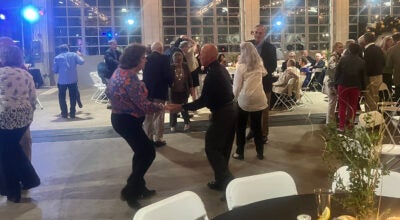Wineka column: The Wall that heals
Published 12:00 am Friday, April 1, 2011
By Mark Wineka
mwineka@salisburypost.com
CONCORD — Mike Stubbs stood by himself and touched the name lightly with his index finger.
On panel 28E of the wall, Luther A. Smith’s name was there with 63 other “Black Lions” who died on that same day, Oct. 17, 1967.
The Battle of Ong Thanh was one of the most ferocious fights of the Vietnam War.
A young Mike Stubbs was with them. An assistant platoon leader, he kept fighting that morning as the Alpha and Delta companies were under a God-awful barrage from a Viet Cong regiment outnumbering the Americans 10-to-1.
Stubbs watched as Smith’s leg was blown off by a rocket-propelled grenade.
“He was my best friend,” Stubbs said.
Stubbs, shot in the neck, was credited with killing 13 Viet Cong. Only 17 days shy of completing his tour, he spent the next nine weeks in military hospitals in Vietnam and Japan before being sent home. He filled out the remainder of his hitch as a drill instructor at Fort Jackson.
“It’s something when you have 64 names all together,” a reflective Stubbs said Thursday morning at “The Wall That Heals,” a half-size replica of the Vietnam Veterans Memorial in Washington, D.C.
The visiting wall, which holds the names of Vietnam’s 58,000-plus casualties, including 17 from Salisbury, 11 from Kannapolis and 13 from Concord, is open to the public around the clock until 9 p.m. Sunday at Frank Liske Park.
It took Stubbs 20 years before he could talk about Ong Thanh. A resident of Harrisburg, he worked many years for the telephone company and is now retired from Lucent Technologies.
He also heads “Wounded Warriors” Chapter 634 of the Military Order of the Purple Heart. Earlier, when he was asked to give remarks at the ceremony marking the traveling exhibit’s opening, Stubbs resisted.
“You don’t need any speech,” he said. “The wall speaks for itself.”
Notebooks on the site help visitors in finding the names they are looking for. Paul D. Walton of Locust stopped at panel 14E and counted down 51 lines to find the name of Charles M. Evans.
“God bless you, Charlie,” he whispered to his high school friend from Watseka, Ill. Evans and Walton played football together, and Walton described him as “a gentle giant,” a lineman who sacrificed his body to make running paths for the rest of the team.
“Then he sacrificed himself for our country,” Walton said.
Evans lost his life in Vietnam in 1967 when the personnel carrier he was riding in rolled over a mine. Close to 20 soldiers were either killed or maimed in the explosion.
“We were close,” Walton said. “I’ll never forget him.”
Walton was a Vietnam-era soldier himself both on active duty and in the reserves from 1964-70, but the closest he got to Vietnam was his two-year stint in Germany. His own father served under Gen. George Patton in World War II, and his son is a lieutenant colonel who has been in the Army 19-and-a-half years.
Today, Walton serves in the Cabarrus County Honor Guard, which provides military rites at the funerals of military veterans.
Walton and fellow Honor Guard member Robert Downer were among the men who helped put up the wall Wednesday after its arrival the day before by motorcycle escort. Downer said they worked two hours in heavy rain and lightning.
So many letters, notes and objects have been left at the Vietnam Veterans Memorial in Washington since its opening in 1982. The traveling exhibit showcases several of those things in its mobile, picture-window-type museum.
A Navy veteran, Downer was especially impressed with those messages to the war’s casualties. As a group, Vietnam soldiers were treated horribly by many of their countrymen back home, especially those who protested the U.S. involvement in Vietnam.
And if the protests weren’t enough, it also was a generation of soldiers whose service often was greatly ignored.
Connie Honbarger said it took almost a month for her young husband’s body to be returned home for burial after he was killed Feb. 10, 1968, in Vietnam. There was no fanfare, motorcades, gun salutes or tributes, she said.
“When he came home, there was nothing,” she said.
Honbarger and her husband, Gary Steven Christenbury, married April 2, 1967. Christenbury was only 19 when he was drafted, and just before Christmas in 1967, he shipped off to Vietnam.
In less than two months, he was killed. His name is on panel 38E.
“It’s still emotional,” Christenbury’s sister Elaine Newsome said.
Both women said seeing his name on the wall and those of all the other soldiers stretching across the park hillside hit them with sadness.
“When you look at this,” Honbarger said, “it kind of puts it in perspective.”
Author David Maraniss wrote extensively about the Battle of Ong Thanh in his 2004 book, “They Marched into Sunlight.”
The soldiers who marched into sunlight that morning in 1967 were shot down by an enemy hiding in tall trees and fortified bunkers, using rifles, machine guns, grenades and Claymore mines.
The Viet Cong’s 271st Regiment — 1,200-men strong — had hidden themselves in a base camp while they were waiting for a shipment of rice.
Stubbs said when the Black Lions of the 2nd Battalion’s 28th Regiment picked their way through the dense jungle and crossed Ong Thahn Creek, the ambush was on.
Ironically, the Alpha Company sergeant’s favorite song — one he was always singing — was the Temptations’ “Knock on Wood.”
Three sharp taps of bamboo sticks was the Viet Cong’s signal to open fire.
The companies came under attack for two hours. Out of roughly 142 soldiers in the two companies, 64 died and most of the rest were wounded.
Stubbs thinks it’s important for the replica wall to be here and for people to talk about Vietnam, no matter how painful it once was for him and others. “You didn’t tell people you had been to Vietnam,” he recalled.
Stubbs has been to the wall in Washington and has touched the names there of Luther A. Smith and his other buddies. Even though it has been almost 44 years, how could he ever forget them?
Or that morning Ong Thanh Creek.
Someday, Stubbs said, he wants to visit the Florida naval base where Smith is buried.
“It’s on my bucket list,” he said.
The Wall That Heals
What: A half-size replica of the Vietnam Veterans Memorial in Washington, D.C.
Where: Frank Liske Park, 4001 Stough Road SW, Concord.
Who: Open to the public.
When: Around the clock until 9 p.m. Sunday.
Cost: No charge. Donations are accepted.
Sponsor: Part of Cabarrus County Public Library’s 2011 “One Book One Community” program, which has featured Tim O’Brien’s novel on Vietnam, “The Things They Carried.”
Purpose: Allows those enshrined on the memorial to exist once more among family and friends. Also, it allows Vietnam veterans who have been unable to cope with facing the wall in Washington to find the strength to do so within their own communities.
Background: The Wall That Heals has been seen by millions of Americans in more than 300 cities throughout the United States since 1996. It is the only traveling replica directly affiliated with the Vietnam Veterans Memorial in Washington. It also includes a mobile museum about the wall.
Contact Mark Wineka at 704-797-4263, or mwineka@salisburypost.com.




